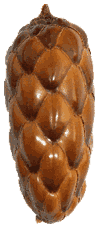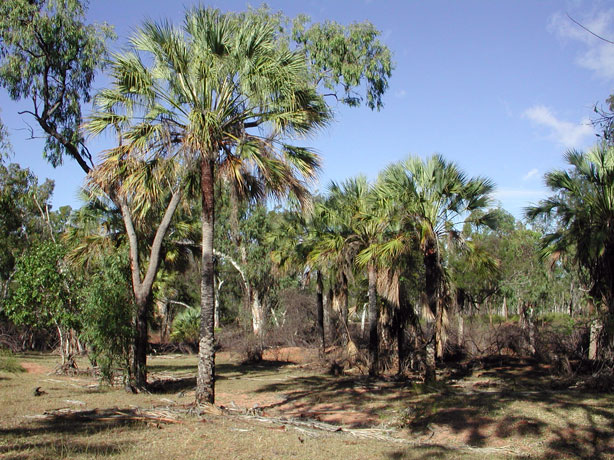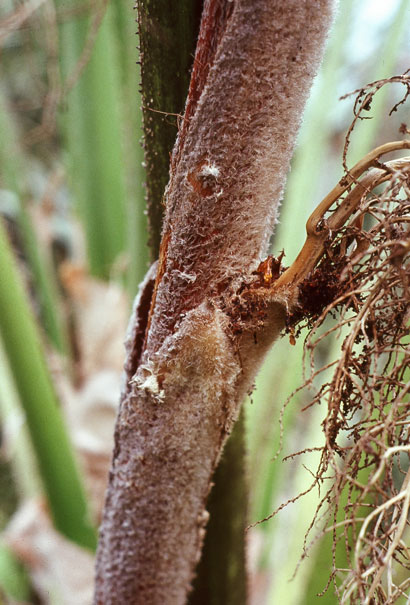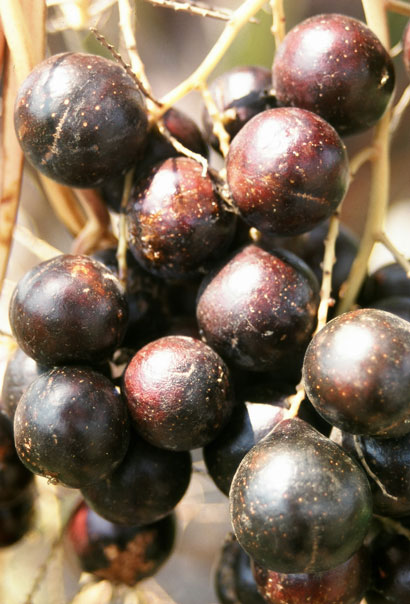 |
Palm |
 |
Palm |
 |
| Plant in habitat, Oaky Creek. Photograph by J.L. Dowe. |
 |
| Inflorescence bract displaying wooly tomentum. Photograph by J.L. Dowe. |
Livistona lanuginosa is confined to the Burdekin River catchment in northeastern Australia between S20º1920.8 to S21º3623.9 and E145º3611.18 to E147º1920, with an altitudinal range of 140270 m. It is a riparian species occurring primarily along the banks of braided stream systems and adjacent floodplains in sandy alluvial soils mostly derived from granite. The climate of the Burdekin River system is strongly seasonal, with unreliable monsoonally influenced summer rain patterns. The average annual rainfall is 600700 mm, and extreme temperatures range from 545 ºC, in an otherwise semi-arid tropical environment. The total population of Livistona lanuginosa consists of not more than ca. 700 mature adults. The main occurrence is in the lower Cape River system (which is an inland tributary of the Burdekin River), on both the Cape River and most of its primary and secondary tributaries. Populations most commonly occur in more or less linear stands along stream edges. There are a few disjunct populations away from the Cape River within the Burdekin River system, but no further than 40 km from the main population on the Cape River and its tributaries.
Livistona lanuginosa is a single stemmed fan-palm, growing to a maximum height of 18 m and a diameter at breast height of 2535 cm. The leaves, about 40, are produced in a rounded crown. The petioles are armed on the margins with single curved spines in the proximal portion. The leaf blade is circular in outline, pale gray-green above, and a lighter gray-green below. The leaf blade is regularly divided into 7090 segments in mature palms. Segments have a thin coating of wax on both surfaces. The paniculate inflorescences are borne within the leaves and are about 200 cm long but not extending beyond the crown. The bracts on the inflorescence are covered in a dense wooly tomentum [lanuginose = wooly], hence both the scientific and common names. Bisexual flowers, yellow to about 3 mm long, are abundant, and crowded onto thin rachillae. Fruit are globose, to 2535 mm diameter, and brown to black at maturity. The endocarp is ca. 2 mm thick and woody. The seed is globose, about 25 mm in diameter. The hard endosperm is partially intruded on one side by a kidney-shaped seed coat intrusion. Apart from some minor horticultural applications, the palm has no known uses.
 |
| Fruits. Photograph by J.L. Dowe. |
The few targeted ecological studies of Livistona lanuginosa were those conducted by the author in general investigation of the genus Livistona in Australia (Dowe 2001), and a survey to determine population structure and dynamics of the species (Pettit & Dowe 2003). Livistona lanuginosa is functionally dioecious and appears to be primarily wind-pollinated. Flowering occurs in the driest part of the year (Spring), and fruiting usually coincides with the Summer rains some 46 months later. Fruits are mainly dispersed by flood waters and settle in debris piles on the stream banks where seeds germinate and seedlings become established. It is not known if mammals or birds are involved in additional seed distribution. Seed germination occurs in the summer following seed-set, and seeds require relatively deep burial as the emergent seedling roots can extend for as much as 100 cm downward into the soil. Subsequent growth is initially slow and, at least in cultivated plants, maturity is reached in 1520 years. Population structure at most sites follows the reverse-J curve model, with large numbers of seedlings and subsequent decreasing numbers of juveniles, subadults and adults. Individuals in populations are usually closely grouped with numerous seedlings and juveniles beneath the parent palms.
There are no parts of the population of Livistona lanuginosa included in either National Parks or designated conservation reserves, as the entire area covered by the species is privately owned or leasehold tenured, and given over to beef cattle grazing. There are a few ex situ populations in botanical gardens, such as the Palmetum and Anderson Park Botanical Garden, Townsville, Australia, and Fairchild Tropical Botanic Garden and Montgomery Botanical Center, Florida, USA. The primary threat to L. lanuginosa is browsing and trampling by cattle, and subsequent habitat alteration such as bank erosion and soil compaction. There are no significant water impoundments upstream of the main population, and water-flow regimes are natural. About half of the individuals in the studied populations are in a senescent state (Pettit and Dowe 2003) with only limited or no regeneration and unbalanced recruitment between class sizes. Overall, regeneration is severely restricted by the impact of cattle.
The species is recognized as Vulnerable by the Queensland Governments Environmental Protection Agency, and it is therefore legislatively protected (Henderson 2002). In effect, no action regarding conservation of the species has been implemented despite the population being in decline and under increasing pressure from grazing. However, with respite from grazing, recovery would be expected in most populations.
Additional field work is required to determine the total population coverage, as some areas where it is suspected to occur are inaccessible and remote. There are legislative provisions within the Nature Conservation Act (Queensland) to declare some populations as conservation reserves, or possible National Parks, but this action would require a concerted effort by multiple government departments and the cooperation of land owners and lease holders. An investigation of genetic diversity across the population is presently being conducted, and this project hopes to achieve some recognition of the vulnerability of the species.
Dr. John Leslie Dowe, Australian Centre for Tropical Freshwater Research, James Cook University, Townsville, QLD, Australia.
Dowe, J. L. 1998.
Regional priorities in Australia and the Pacific islands.
In: Status Survey and Conservation Action Plan: Palms, Their Conservation and Sustained Utilization (ed. D. Johnson). pp.7985. IUCN/SSC
Palm Specialist Group, Gland, Switzerland.
Dowe, J.L. 2001.
Studies in the genus Livistona (Coryphoideae: Arecaceae).
PhD Thesis, James Cook University, Townsville, Australia.
Henderson, R.J.F. (ed.) 2002.
Names and distribution of Queensland plants, algae and lichens.
Queensland Environmental Protection Agency, Toowong.
Pettit, N.E. & Dowe, J.L. 2003.
Distribution and population structure of the vulnerable riparian palm Livistona lanuginosa A.N.Rodd (Arecaceae) in the Burdekin River catchment, north Queensland.
Pacific Conserv. Biol. 9: 207214.
Rodd, A.N. 1998.
Revision of Livistona (Arecaceae) in Australia.
Telopea 8: 49153.